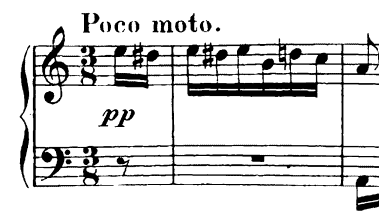It seems like nearly everybody has wanted to learn Beethoven’s Fur Elise at some point. It’s become one of the most famous pieces of classical music of all time, but how hard is it to learn?
Fur Elise by Beethoven is about ABRSM grade 5 standard, or RCM Level 7. However, the opening of the piece, which is the most well-known part that most people will recognise, is easier than the middle section and is around grade 2 ABRSM standard.
What Grade is the First Part of Fur Elise?
The beginning of Fur Elise (the first 43 bars/measures) is the section that most people will recognise as Fur Elise, and is the part that most people want to learn when they think about learning Fur Elise. This opening section is an easier standard than bar/measure 44 onwards. It’s about a grade 2 ABRSM standard.

One of the features that makes this section easier than the rest of the piece is that for the majority of the time in this opening section, only one note is being pressed down at any one time. It doesn’t necessarily sound like this is the case, because there may be some sustain pedal blurring the notes into each other, but it’s only the first beats of the bars/measures that ever have the right-hand and left-hand playing together.
This means slightly less multitasking and slightly more brain power left over for whichever hand is currently playing.
There are lots of pieces set on the current and previous ABRSM grade 2 syllabuses where most of the time only one hand is playing a note rather than both hands together, such as Angelfish by Anne Crosby Gaudet, March Hare by Brian Chapple, Get in Step by Christopher Norton…
However, the opening of Fur Elise covers a large range of notes with lots of octave jumps, and there are lots of accidentals (added sharps) and the use of the sustain pedal, which definitely makes it harder than grade 1 standard.
What Grade is Fur Elise as a Whole?
Fur Elise in its entirety is officially on the RCM Level 7 syllabus under List B, and whilst it’s not (currently) on the ABRSM or Trinity College London syllabuses, it’s about a grade 5 standard when compared to pieces that are on those syllabuses.
The music in Fur Elise becomes an approximate grade 5 standard from bar 44 where we have 4 and 6-note chords, followed by grace notes, bars where both hands are playing semiquavers/16th notes at the same time, and bars where the right hand is playing demi-semiquavers/32nd notes.

There are also demi-semiquavers/32nd notes in the right hand of Mozart’s Andante in B Flat K.15ii, which used to be set for grade 5 ABRSM on the 2007 – 2008 syllabus. Whilst Fur Elise is played at a faster tempo/speed than this Mozart piece, it is also in C major which is generally considered to be an easier key signature, which is why I believe it balances out to say that Fur Elise is a grade 5 standard.

Fur Elise is also a longer piece than the pieces typically set on exam boards around this difficulty level. Fur Elise is 125 bars/measures long. If we compare that to another Beethoven piece which is on the grade 5 ABRSM syllabus for 2021 and 2022, Beethoven’s Bagatelle in G minor Opus 119 No. 1, that is 91 bars/measures long including repeats.
There is also a chromatic scale near the end of the piece, before the opening section returns for the final time, although some exam boards get you to learn chromatic scales from grade 2 anyway.
How Long Does It Take to Learn Fur Elise?
If you wanted to, you could learn the most recognisable part of Fur Elise (the first 8 bars/measures) in one day. The first 8 bars/measures then immediately repeat, so you could learn the first 16 bars/measures very quickly. You could learn it from reading the sheet music, watching videos, or taking online or in-person piano lessons.
I think it’s really cool that the opening of Fur Elise is less difficult than later on in the piece, because it means that it’s more accessible and the majority of people can learn the opening without having to learn the whole piece, but the option is always there to learn the rest of the piece later as people’s piano ability increases.
If you want to learn the whole of Fur Elise and not just the first 8 bars, then your teacher can guide you to learning it in sections, but here’s an example practice plan that you could use:
| Practice session | Bars/measures | What to practice |
| 1 | 1 – 8 | Usually I recommend learning things hands separately first (just right hand and then just left hand before putting the hands together) but it doesn’t make that much sense here because most of the time only one hand it’s playing at once, so you can just learn the first 8 bars/measures as it’s written. |
| 2 | 1 – 16 | Bars/measures 9 – 16 are the same as 1 – 8 which makes it easy to learn these next 8 bars/measures! Practice playing it fluently and see if you can play all 16 bars/measures without stopping. |
| 3 | 16 – 23 | You can then learn this new section hands together straightaway. |
| 4 | 1 – 23 | Now is a good opportunity to put what you have learned so far altogether. |
| 5 | 1 – 44 | Bars/measures 24 – 44 are a repeat of what you have already learned, so you can add this on. |
| 6 | 44 – 51 | Now is where I would recommend learning things hands separately. You could learn the right hand first of this section. |
| 7 | 44 – 51 | Now learn the left hand. |
| 8 | 44 – 51 | Now you can practice this section both hands together. |
| 9 | 51 – 59 | The same with this section. Learn the right hand first. |
| 10 | 51 – 59 | Then you can learn the left hand. |
| 11 | 51 – 59 | Then both hands together. |
| 12 | 60 – 80 | This section is material that you already know, so you can add it in. |
| 13 | 81 – 98 | Learn the right hand of this first. |
| 14 | 81 – 98 | Then then the left hand. |
| 15 | 81 – 98 | Then both hands together. |
| 16 | 1 – 98 | Now would be a good opportunity to put everything together and practice playing from the beginning up until here. |
| 17 | 99 – 103 | Learn the right hand of this. |
| 18 | 99 – 103 | Learn the left hand of this, and as it is fairly simple, then you can put it together with the right hand. |
| 19 | 1 – 125 | The last section of this piece is a repeat of the material that you already know, so you can put everything together and play the whole piece! |
You might be interested in reading: How Long Does it Take to Do Grade 1 Piano?
Is Fur Elise or Moonlight Sonata Easier for a Beginner?
Fur Elise is easier to learn than Moonlight Sonata. Fur Elise is between a grade 2 and grade 5 standard depending on whether you just learn the opening or whether you learn the whole piece. The most well-known movement of Moonlight Sonata, the first movement, is minimum grade 6 standard.
To learn more about what standard Moonlight Sonata is, check out this more in-depth blog post that I wrote about what standard Beethoven’s Moonlight Sonata is.
Thanks for reading! Check out some similar articles:

